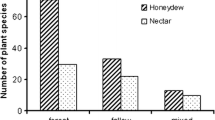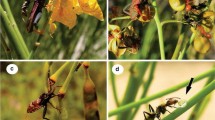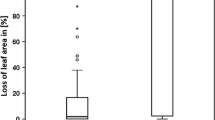Abstract
Extrafloral nectar of plants and honeydew of hemipterans is a food source extensively explored by ants. Although basically a sugary liquid food, nectar and honeydew are composed of different nutrients and offered in distinct ways; thus, ants must interact differently with plants and hemipterans. In this study we assessed the availability and dominance of nectar of extrafloral nectaries and honeydew of sap-sucking hemipterans (i.e., sugar-based resources) as mechanisms regulating interaction frequency and structuring ant-plant-hemipteran networks. We studied 12 plant species (240 shrubs, 20 per species) and 12 hemipteran species (240 aggregations, 20 per species) that interacted with 26 ant species in an area of Rupestrian Fields (Rocky Montane Savannah), Brazil. We observed that the 7 ant species that collected honeydew were a subset of the 25 ant species feeding on nectar, but the highly interacted species Camponotus crassus was the same for both subnetworks. The ant-plant subnetwork exhibited a nested pattern of interaction with a low degree of specialization, while the ant-hemipteran subnetwork exhibited lower nestedness but higher specialization. We found a positive relationship between the offer of EFNs and the number of interactions with ants, probably resulting from reduced competition in plants with high availability of EFNs. However, hemipteran species that were most abundant did not interact with more species of ants, probably because of the numerical dominance of the species tending all hemipteran aggregations, regardless of size. However, segregation between ant species was higher than expected by chance for both plants and hemipterans, confirming a deterministic factor (i.e., competition between ant species) regulating the frequency of interactions. In summary, the availability of ENFs seems to be an important mechanism regulating ant-plant interactions, while numerical dominance seems to be an important mechanism structuring ant-hemipteran interactions.



Similar content being viewed by others
References
Alves RJV, Silva NG, Oliveira JA, Medeiros D (2014) Circumscribing Campo rupestre—megadiverse Brazilian rocky montane savanas. Braz J Biol 74:355–362. doi:10.1590/1519-6984.23212
Bascompte J, Jordano P (2007) Plant–animal mutualistic networks: the architecture of biodiversity. Annu Rev Ecol Evol S 38:567–593. doi:10.1146/annurev.ecolsys.38.091206.095818
Becerra JX, Venable DL (1989) Extrafloral nectaries: a defense against ant–Homoptera mutualisms? Oikos 55:276–280
Blüthgen N, Fiedler K (2004) Competition for composition: lessons from nectar–feeding ant communities. Ecology 85:1479–1485. doi:10.1890/03-0430
Blüthgen N, Stork NE (2007) Ant mosaics in tropical rainforest in Australia and elsewhere: a critical review. Austral Ecol 32:93–104. doi:10.1111/j.1442-9993.2007.01744.x
Blüthgen N, Verhaagh M, Goitia W, Jaffé K, Morawetz W, Barthlott W (2000) How plants shape the ant community in the Amazonian rainforest canopy the key role of extrafloral nectaries and hemipteran honeydew. Oecologia 125:229–240. doi:10.1007/s004420000449
Blüthgen N, Gottsberger G, Fiedler K (2004) Sugar and amino acid composition of ant-attended nectar and honeydew sources from an Australian rainforest. Austral Ecol 29:418–429. doi:10.1111/j.1442-9993.2004.01380.x
Blüthgen N, Mezger D, Linsenmair KE (2006) Ant–hemipteran trophobiosies in a Bornean rainforest-diversity, specificity and monopolization. Insect Soc 53:194–203. doi:10.1007/s00040-005-0858-1
Blüthgen N, Menzel F, Hovestadt T, Fiala B, Blüthgen N (2007) Specialization, constraints, and conflicting interests in mutualistic networks. Curr Biol 17:341–346. doi:10.1016/j.cub.2006.12.039
Buckley RC (1987) Interactions involving plants, Homoptera, and ants. Annu Rev Ecol Syst 18:111–135. doi:10.1146/annurev.es.18.110187.000551
Byk J, Del-Claro K (2011) Ant–plant interaction in the Neotropical savannah: direct beneficial effects of extrafloral nectar on ant colony fitness. Pop Ecol 53:327–332. doi:10.1007/s10144-010-0240-7
Campos RI, Camacho GP (2014) Ant–plant interactions: the importance of extrafloral nectaries versus hemipteran honeydew on plant defense against herbivores. Arthropod-Plant Int 8:507–512. doi:10.1007/s11829-014-9338-8
Carroll CR, Janzen DH (1973) Ecology of foraging by ants. Annu Rev Ecol Syst 4:231–257. doi:10.1146/annurev.es.04.110173.001311
Chamberlain SA, Kilpatrick JR, Holland JN (2010) Do extrafloral nectar resources, species abundances, and body sizes contribute to the structure of ant–plant mutualistic networks? Oecologia 164:741–750. doi:10.1146/annurev.es.04.110173.001311
Costa FV, Mello R, Lana TC, Neves FS (2015) Ant fauna in megadiverse mountains: a checklist for the rocky grasslands. Sociobiology 62:228–245
Cushman JH, Addicott JF (1989) Intra- and interspecific competition for mutualists: ants as a limited and limiting resource for aphids. Oecologia 79:315–321. doi:10.1007/BF00384310
Dáttilo W, Guimarães PR, Izzo TJ (2013) Spatial structure of ant–plant mutualistic networks. Oikos 122:1643–1648. doi:10.1111/j.1600-0706.2013.00562.x
Dáttilo W, Díaz-Castelazo C, Rico-Gray V (2014a) Ant dominance hierarchy determines the nested pattern in ant–plant networks. Biol J Linn Soc 113:405–414. doi:10.1111/bij.12350
Dáttilo W, Fagundes R, Gurka CAQ, Silva MSA, Vieira MCL, Izzo TJ, Díaz-Castelazo C, Del-Claro K, Rico-Gray V (2014b) Individual-based ant–plant networks: diurnal–nocturnal structure and species–area relationship. PLoS ONE 9:e99838. doi:10.1371/journal.pone.0099838
Dáttilo W, Marquitti FMD, Guimarães PR, Izzo TJ (2014c) The structure of ant–plant ecological networks: is abundance enough? Ecology 95:475–485. doi:10.1890/12-1647.1
Davidson DW, Cook SC, Snelling RR, Chua TH (2003) Explaining the abundance of ants in lowland tropical rainforest canopies. Science 300:969–972. doi:10.1126/science.1082074
Dejean A, Corbara B (2003) A review of mosaics of dominant ants in rainforests and plantations. In: Basset Y, Novotny V, Miller SE (eds) Arthropods of tropical forests: spatio-temporal dynamics and resource use in the canop. Cambridge University Press, New York, pp 341–347
Delabie JHC (2001) Trophobioses between Formicidae and Hemiptera (Sternorrhyncha and Auchenorrhyncha): an overview. Neotrop Entomol 30:501–516. doi:10.1590/S1519-566X2001000400001
Del-Claro K (2004) Multitrophic relationships, conditional mutualisms, and the study of interaction biodiversity in Tropical Savannas. Neotrop Entomol 33:665–672. doi:10.1590/S1519-566X2004000600002
Del-Claro K, Rico-Gray V, Torezan-Silingardi HM, Alves-Silva E, Fagundes R, Lange D, Dattilo W, Villela AA, Aguirre A, Morales D (2016) Loss and gains in ant–plant interactions mediated by extrafloral nectar: fidelity, cheats and lies. Insectes Soc. doi:10.1007/s00040-016-0466-2
Estatcamp Equipe (2014) Software action. Estatcamp- Consultoria em estatística e qualidade, São Carlos
Fagundes R, Del-Claro K, Ribeiro SP (2012) Effects of the trophobiont herbivore Calloconophora pugionata (Hemiptera) on ant fauna associated with Myrcia obovata (Myrtaceae) in a montane tropical forest. Psyche 2012:1–8. doi:10.1155/2012/783945
Fagundes R, Ribeiro SP, Del-Claro K (2013) Tending-ants increase survivorship and reproductive success of Calloconophora pugionata Drietch (Hemiptera, Membracidae), a trophobiont herbivore of Myrcia obovata O. Berg (Myrtales, Myrtaceae). Sociobiology 60:11–19. doi:10.13102/sociobiology.v60i1.11-19
Falcão JCF, Dáttilo W, Izzo TJ (2014) Temporal variation in extrafloral nectar secretion in different ontogenic stages of the fruits of Alibertia verrucosa S. Moore (Rubiaceae) in a Neotropical savanna. Journal of Plant Interactions 9:137–142
Fischer MK, Hoffmann KH, Völkl W (2001) Competition for mutualists in an ant–homopteran interaction mediated by hierarchies of ant attendance. Oikos 92:531–541. doi:10.1034/j.1600-0706.2001.920314.x
Gotelli NJ (2000) Null model analysis of species co-occurrence patterns. Ecology 81:2606–2621. doi:10.1890/0012-9658(2000)081[2606:NMAOSC]2.0.CO;2
Guerra TJ, Camarota F, Castro FS, Schwertner CF, Grazia J (2011) Trophobiosis between ants and Eurystethus microlobatus Ruckes 1966 (Hemiptera: Heteroptera: Pentatomidae) a cryptic, gregarious and subsocial stinkbug. J Nat Hist 45:1101–1117. doi:10.1080/00222933.2011.552800
Guimarães PR Jr, Guimarães PR (2006) Improving the analyses of nestedness for large sets of matrices. Environ Modell Softw 21:1512–1513. doi:10.1016/j.envsoft.2006.04.002
Guimaraes PR Jr, Machado G, de Aguiar MA, Jordano P, Bascompte J, Pinheiro A, dos-Reis SF (2007) Build-up mechanisms determining the topology of mutualistic networks. J Theor Biol 249:181–189. doi:10.1016/j.jtbi.2007.08.004
Guimarães PR, Rico-Gray V, Dos-Reis SF, Thompson JN (2006) Asymmetries in specialization in ant–plant mutualistic networks. Proc R Soc B Biol Sci 273:2041–2047. doi:10.1098/rspb.2006.3548
Heil M, Fiala B, Baumann B, Linsenmair KE (2000) Temporal, spatial and biotic variations in extrafloral nectar secretion by Macaranga tanarius. Funct Ecol 14:749–775. doi:10.1046/j.1365-2435.2000.00480.x
Katayama N, Suzuki N (2003) Changes in the use of extrafloral nectaries of Vicia faba (Leguminosae) and honeydew of aphids by ants with increasing aphid density. Ann Entomol Soc Am 96:579–584. doi:10.1603/0013-8746(2003)096[0579:CITUOE]
Lange D, Del-Claro K (2014) Ant–plant interaction in a tropical savanna: may the network structure vary over time and influence on the outcomes of associations? PLoS ONE 9:e105574. doi:10.1371/journal.pone.0105574
Lange D, Dáttilo W, Del-Claro K (2013) Influence of extrafloral nectary phenology on ant–plant mutualistic networks in a neotropical savanna. Ecol Entomol 38:463–469. doi:10.1111/een.12036
Lewinsohn TM, Prado I, Jordano P, Bascompte JM, Olesen J (2006) Structure in plant–animal interaction assemblages. Oikos 113:174–184. doi:10.1111/j.0030-1299.2006.14583.x
Majer JD, Delabie JH, Smith MR (1994) Arboreal ant community patterns in Brazilian cocoa farms. Biotropica 26:73–83
Marquitti FMD, Guimaraes PR, Pires MM, Bittencourt LF (2014) MODULAR: software for the autonomous computation of modularity in large network sets. Ecography 37:221–224. doi:10.1111/j.1600-0587.2013.00506.x
Moreira VSS, Del-Claro K (2005) The outcomes of an ant–treehopper association on Solanum lycocarpum St. Hill: increased membracid fecundity and reduced damage by chewing herbivores. Neotrop Entomol 34:881–887. doi:10.1590/S1519-566X2005000600002
Moya-Raygoza G, Larsen KJ (2001) Temporal resource switching by ants between honeydew produced by the fivespotted gama grass leafhopper (Dalbulus quinquenotatus) and nectar produced by plants with extrafloral nectaries. Am Nat 146:311–320. doi:10.1674/0003-0031(2001)146[0311:TRSBAB]
Nascimento EA, Del-Claro K (2010) Ant visitation to extrafloral nectaries decrease herbivory and increase fruit set in Chamaecrista debillis (Fabaceae) in a neotropical savanna. Flora 205:754–756. doi:10.1016/j.flora.2009.12.040
Parr CL, Gibb H (2010) Competition and the role of dominant ants. In: Lach L, Parr CL, Abott KL (eds) Ant ecology. Oxford University Press, Oxford, pp 77–96
R Development Core Team (2009) R: a language and environment for statistical computing. R Foundation for Statistical Computing, Vienna
Ribas CR, Schoereder JH, Pic M, Soares SM (2003) Tree heterogeneity, resource availability, and larger scale processes regulating arboreal ant species richness. Austral Ecol 28:305–314. doi:10.1046/j.1442-9993.2003.01290.x
Rico-Gray V, Oliveira PS (2007) The ecology and evolution of ant–plant interactions. University of Chicago Press, Chicago
Rico-Gray V, Díaz-Castelazo C, Ramirez-Hernandez A, Guimarães PR, Holland JN (2012) Abiotic factors shape temporal variation in the structure of an ant–plant network. Arthropod-Plant Inte 6:289–295. doi:10.1007/s11829-011-9170-3
Rosumek FB, Silveira FA, Neves FDS, Barbosa NPDU, Diniz L, Oki Y, Pezzini F, Fernandes GW, Cornelissen T (2009) Ants on plants: a meta-analysis of the role of ants as plant biotic defenses. Oecologia 160:537–549. doi:10.1007/s00442-009-1309-x
Santos GM, Dáttilo W, Presley SJ (2014) The seasonal dynamic of ant–flower networks in a semi-arid tropical environment. Ecological Entomol 39:674–683. doi:10.1111/een.12138
Staab M, Blüthgen N, Klein A (2014) Tree diversity alters the structure of a tri-trophic network in a biodiversity experiment. Oikos 2014:1–8. doi:10.1111/oik.01723
Stone L, Roberts A (1990) The checkerboard score and species distributions. Oecologia 85:74–79. doi:10.1007/BF00317345
Styrsky JD, Eubanks MD (2006) Ecological consequences of interactions between ants and honeydew-producing insects. PNAS 274:151–164. doi:10.1098/rspb.2006.3701
Vázquez DP, Blüthgen N, Cagnolo L, Chacoff NP (2009) Uniting pattern and process in plant–animal mutualistic networks: a review. Ann Bot Lond 103:1445–1457. doi:10.1093/aob/mcp057
Way MJ, Khoo KC (1992) Role of ants in pest management. Annu Rev Entomol 37:479–503
Wittman SE, Sanders NJ, Ellison AM, Jules ES, Ratchford JS, Gotelli NJ (2010) Species interactions and thermal constraints on ant community structure. Oikos 119:551–559. doi:10.1111/j.1600-0706.2009.17792.x
Acknowledgments
We thank the IBAMA (28125-1) and IEF (064/11) for environmental licenses, UFOP for logistic support, and UFOP and UFU for financial support. We thank Helena Maura Torezan-Silingardi, Denise Lange, Solange Augusto, Gilberto Santos and Juliane Lopes, and the two anonymous reviewers, for the suggested manuscript improvements. We thank Ana Peronti (UFSCar), Maria Cristina Messias (UFOP) and Rodrigo Feitosa (UFPR) for confirming hemipteran, plant and ant identifications, respectively. CAPES and CNPq supported RF; CNPq and CAPES supported KDC, and CNPq supported SPR.
Author information
Authors and Affiliations
Corresponding author
Additional information
Handling Editor: Heikki Hokkanen.
Rights and permissions
About this article
Cite this article
Fagundes, R., Dáttilo, W., Ribeiro, S.P. et al. Food source availability and interspecific dominance as structural mechanisms of ant-plant-hemipteran multitrophic networks. Arthropod-Plant Interactions 10, 207–220 (2016). https://doi.org/10.1007/s11829-016-9428-x
Received:
Accepted:
Published:
Issue Date:
DOI: https://doi.org/10.1007/s11829-016-9428-x




